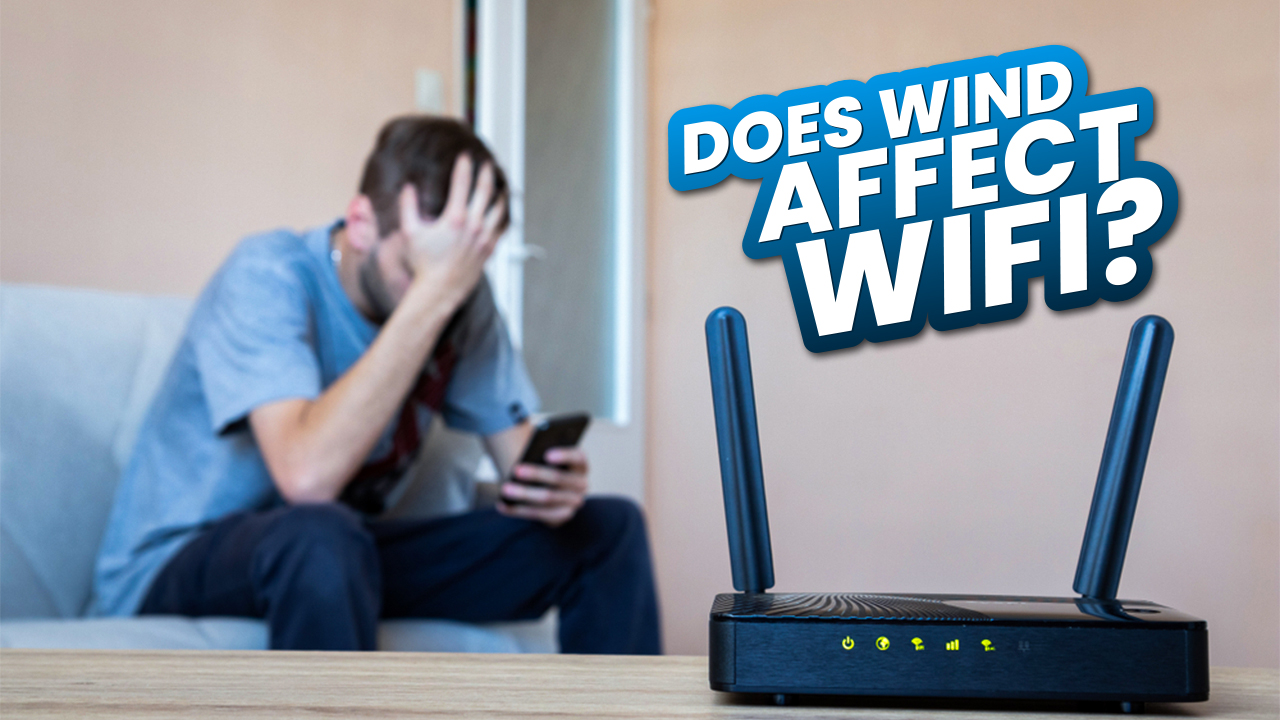Have you ever looked out your window on a windy day and wondered if the gusts of air swirling around outside could be affecting your WiFi? You’re not alone in pondering this intriguing question. In our hyperconnected world, where the internet is an essential part of daily life, the impact of weather on our online experience is a genuine curiosity.
Wind does not directly impact Wi-Fi signals, but can indirectly affect connections by swaying hardware like routers or satellite dishes, knocking down power lines, or damaging outdoor networking equipment. Wireless and satellite internet are more susceptible to weather interference than wired networks.
However, there is more to it than that. In this article, we will be doing some intersection between meteorology and technology to uncover whether there’s any truth to the idea that weather conditions can influence your internet connection. Can a strong wind or a rainstorm really slow down your WiFi, disrupting your online activities?
More importantly, we’ll provide practical insights to help you maintain a consistent connection, regardless of the weather outside.
How Does WiFi Work?
WiFi has become such an integral part of our daily lives that it’s easy to take for granted. But how exactly does it work? WiFi, short for Wireless Fidelity, is a wireless network technology that uses radio waves to provide high-speed internet and network connections.
At its most basic, WiFi works by using radio transmitters and receivers called routers and wireless access points. These devices communicate with each other and with computers, phones, and other devices equipped with WiFi adapters. The wireless access point, or router, connects to the internet via a physical wired connection. It then essentially converts and transmits that signal into radio waves.
When you connect to a WiFi network, your WiFi adapter tunes itself to the same frequency being broadcast by the router. It encodes your data using WiFi protocols and transmits it to the router. The router then directs that data wherever it needs to go.
Does Wind Affect WIFI?
Nowadays, in almost every home, you’ll find a trusty Wi-Fi router, diligently transmitting signals within the house. For obvious reasons, wind won’t disrupt this internal Wi-Fi network.
However, the journey of your internet data from the wider online world to your home involves a more complex infrastructure. The majority of internet traffic now travels through underground and underwater fiber optic cables, a far cry from the satellite-based transmissions of decades past. Today, only a tiny fraction of internet traffic is sent via satellite.
The key point here is that wind, by itself, has little impact on the transmission of this data. It’s not the wind that affects your internet signal but rather the potential consequences of severe weather conditions. For instance, if the wind damages power lines or other critical infrastructure responsible for transmitting data, it can lead to disruptions in your internet service.
Moreover, it’s worth noting that Wi-Fi operates within the broader spectrum of electromagnetic waves. These waves, including those used for Wi-Fi, can pass through the air with ease. They are not significantly affected by normal atmospheric conditions.
In essence, heavy wind alone is not a cause for concern when it comes to your internet signal, particularly if your internet connection relies on robust fiber optic cables and remains within the confines of your home. If you experience a poor signal, other factors are likely at play, such as rain or using Wi-Fi to bridge connections between buildings rather than within them.
So, while you may notice occasional internet slowdowns during storms, rest assured that the wind itself is not the primary culprit. Understanding the science behind internet connectivity can help you troubleshoot effectively and ensure a reliable online experience, regardless of the weather outside.
Indirect Effect of Weather on the Internet
While it’s clear that wind alone doesn’t significantly affect your internet signal, there is an indirect relationship between extreme weather conditions and internet service. Let’s delve into this aspect to understand how weather can have an impact.
Infrastructure Vulnerability
As mentioned earlier, severe weather, including strong winds and storms, can potentially damage critical infrastructure such as power lines, which are vital for transmitting data. When this occurs, it can lead to temporary service disruptions or slowdowns. So, while wind doesn’t directly harm the internet, it can indirectly affect it by compromising the infrastructure that supports it.
Network Congestion
Another indirect effect stems from the behavior of internet users during extreme weather events. When people are forced to stay indoors due to bad weather, there’s often an uptick in network traffic. More individuals accessing the internet simultaneously can lead to network congestion, where the network’s capacity is strained, resulting in reduced internet speeds. This can make your online experience slower than usual.
Traffic Management
Network congestion and traffic management are not new challenges in the world of internet service. Internet service providers (ISPs) sometimes employ speed throttling during peak usage periods to manage network demands effectively. This means that during times when many users are online, your internet speeds may not match the expected levels.
High Traffic During Prolonged Bad Weather
The situation can be exacerbated during prolonged bad weather conditions or when a significant portion of a country experiences unfavorable weather. For instance, during the lockdowns of 2020, when more people were confined to their homes, internet usage surged. The result? Internet service providers faced the challenge of meeting the increased demand for bandwidth.
Ongoing Network Enhancements
It’s worth noting that ISPs continually work to enhance their networks’ bandwidth capabilities. They invest in infrastructure improvements to ensure that the internet can accommodate the growing number of users and their increasing data needs.
How Weather Affects Different Types Of Connections?
When it comes to internet connections, weather can play a role in the quality and reliability of your service. While any connection can theoretically be affected by weather, some are more susceptible than others.
| Connection Type | Weather Issues | Impact On Connection |
| Optical Fiber | Resistant to most weather | Only likely to go down during outages |
| Wireless Home Internet | Rain | Spotty Connection |
| Cable Internet | Extreme Cold | Lines may crack in extreme cold, but most likely to go down due to an outage |
| 4G LTE and 5G Internet | Rain | Spotty Connection |
| Satelite | Rain, extreme heat, snow buildup, high winds | Dropped or spotty connection |
| WiFi | Extreme heat | Dropped or spotty connection |
Let’s examine how weather can impact your internet based on the type of connection you have:
Wired Internet Connections
Wired internet connections, such as cable or fiber optics, are generally more resilient when it comes to weather-related issues. You’re unlikely to experience frequent interruptions or significant slowdowns due to weather conditions. However, there are specific situations where weather can still have an impact:
- Outages: Weather can indirectly affect wired connections by causing power outages in your area. These outages can disrupt your internet service if the equipment used by your Internet Service Provider (ISP) loses power.
- Flooding: In regions prone to flooding, underground wires used for wired connections could be damaged. Flooding can potentially lead to service interruptions until the infrastructure is repaired.
Wireless Internet Connections
Wireless internet connections, including satellite and Wi-Fi, are more susceptible to weather interference. Here’s how different wireless connections are affected:
- Satellite: Satellite internet is the most susceptible to weather-related disruptions. This is because the signal has to travel a long distance through the atmosphere to reach and communicate with satellites in orbit. Any atmospheric disturbances, such as heavy rain or storms, can interfere with the signal and result in slower speeds or even temporary outages.
- Wi-Fi: Wi-Fi, while more robust than satellite, can also be affected by weather conditions, albeit to a lesser extent. The signal can be weakened when it passes through walls and windows, and inclement weather can exacerbate this effect. In particular, heavy rain can absorb and scatter Wi-Fi signals, potentially leading to slower connections or occasional dropouts.
when considering your internet connection and its vulnerability to weather, it’s essential to understand the type of connection you have.
Does Wind Affect Mobile Internet?
Many of us do use the internet over our mobile network instead of connecting to Wi-Fi. Phone data and cell reception is sent over the open airwaves, but is it really impacted by weather?
The good news is that mobile data is not affected by wind alone. Like Wi-Fi, mobile data uses radio frequency (RF) waves which can pass through the air unaffected. Cellphone signals operate on the same electromagnetic spectrum as Wi-Fi, just at slightly different wavelengths. So wind does not directly disrupt the mobile signal.
However, heavy rain or lightning accompanying high winds can potentially interfere with cell towers and service. But there is no direct effect from wind alone on the cell signal, as long as the infrastructure remains intact. The mobile internet signal transmission behaves similarly to Wi-Fi when it comes to wind.
How to Troubleshoot Your Internet Connection in Bad Weather
If your internet connection is acting up during stormy weather, there are some steps you can take to diagnose and hopefully resolve the issue.
First, check if there are any widespread outages in your area. If your cell phone is working, use the data to check your provider’s website or give them a call to see if they have reported any known issues. If your cell phone has also lost signal, that likely indicates a large local outage affecting multiple services.
When safe, visually inspect equipment outside like your satellite dish for any damage from the weather.
If you have power, check your wireless router or internet device inside your home. Try unplugging your router, waiting a few minutes, then plugging it back in to reset it – this simple fix resolves many problems.
If issues persist, contact your internet provider’s customer support for troubleshooting tips or to determine if a technician visit is required. With some diligent checks and resets, you can often resolve weather-related internet woes. But for continued problems, rely on your provider for solutions.
Tips for Maintaining Reliable WiFi During Windy Weather
Unreliable WiFi during windy weather can be frustrating. Here are some tips on maintaining your wireless internet connection when the wind causes interference.
- Don’t assume wind is automatically the cause of WiFi issues – first eliminate other common factors like distance from router, outdated network devices, interference from other electronics. Resetting routers/devices and updating firmware can help optimize performance.
- If wind causes consistent WiFi disruption, especially between buildings, it may be interfering. Heavy rain is more likely the culprit than wind alone.
- Boost your WiFi network coverage in windy areas by using range extenders, powerline adapters or mesh systems. This expands signal reach and provides more reliable wired and wireless access.
- Check for service outages with your Internet provider during extreme weather. High winds can sometimes damage infrastructure leading to disruption.
- Consider moving your router to a more central location if wind causes frequent dropped signals in certain rooms. Elevating it higher can also improve transmission.
- When winds are high, get closer to the router or remove obstructions between devices to maintain better connection. WiFi naturally weakens over distance.
- For outdoor buildings and extensions, expect some WiFi degradation. Use wired access point connections if possible, or look into wireless bridge links to overcome wind interference.
Wrapping Up
In most cases, wind does not directly interfere with WiFi or mobile signals. But extreme weather can still cause internet issues by damaging infrastructure.
If wind disrupts your wireless connection, try relocating your router, eliminating obstructions, using signal boosters and checking for provider outages. Resetting network equipment can also help.
With some troubleshooting and upgrades, you can maintain fast, reliable internet even when it’s blustery out. While wind doesn’t affect signals, safeguarding your connection will prevent weather-related problems.







